AI training apps are a major innovation in the world of sports, pushing athletes to new heights. AI-powered training applications can bypass some of the obstacles that limit human coaches. For example, these apps can provide individualized feedback, track progress, and adapt to the specific needs of each user at any time and place. As a result, virtual coaching apps are becoming increasingly popular for achieving personal goals.
We will look at how the development of AI personal coaching apps is changing sports training, and prove that they give athletes of all levels the opportunity to improve their skills and unlock their full potential.
Our case study shows how the CHI Software team took on the challenge of developing a scalable AI coaching app that helped many users improve their table tennis skills through an intuitive and accessible mobile platform.
This article describes the following:
– Advantages of AI-driven coaching app solutions compared to traditional coaching, like 24/7 availability, cost-effectiveness, and accessibility in any location;
– There are several sections of AI algorithms that can be helpful in training apps, such as computer vision (posture assessment and object detection), machine learning (clustering and classification algorithms), reinforcement learning (deep Q learning, policy gradient methods), and others.
– Humango and Sportsbox AI are two successful examples of AI coaching apps created for both professional and amateurathletes;
– Best practices of AI-based coaching app development include designing a user-friendly interface, properly securing user data, applying scalability strategies, and continuous training of AI models.
AI-Powered vs Traditional Coaching
How exactly is AI revolutionizing our approach to skills development? Let’s take a closer look.
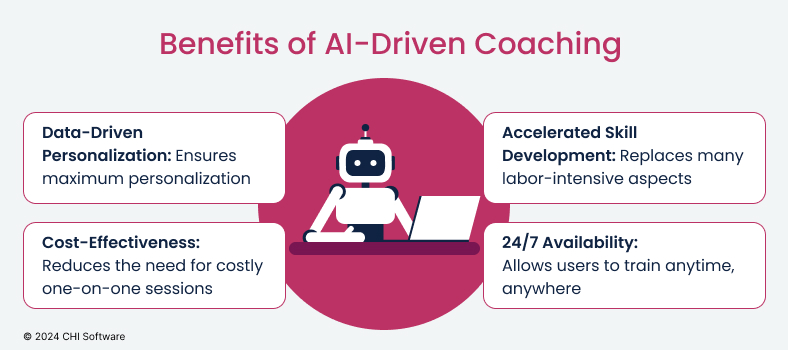
Learn how you can benefit from implementing AI in your application.
Data-Driven Personalization
Human coaches provide the athletes they train with personalized advice, bringing their experience, intuition and creativity to the process. A powerful advantage of traditional coaching is that trainers can create an exclusive programme that adapts their methods to the specific needs and context of the individual. Rich real-world experience is something that artificial intelligence may lack.
On the other hand, humans cannot analyze large amounts of data to personalize their approach to each athlete in the same way computers can. This is where AI-based training apps shine. Utilizing the principles of AI assistant development, these platforms can process vast amounts of data collected during sports sessions. AI apps provide personalized recommendations and insights tailored to each user’s needs, applying previously obtained data to enhance training outcomes.
This automated approach also guarantees accurate and targeted advice for the athlete. The process of improving skills can be more efficient and faster.
Accelerated Skill Development
Coaches are limited by time, energy level, the state of their health, and many other factors that can get in the way of communicating with athletes. In this case, the best way to save time is to develop an AI-powered coaching app.
Using an AI coach and following its tips, users are treated to a unique experience, receiving real-time feedback and personalized exercises that align with their specific goals. This personalized approach makes the audience easier for them to develop.
Accountability and Motivation
A human coach can give a mentee a strong sense of responsibility and motivation to act despite all obstacles. Motivation is undoubtedly one of the most potent driving forces in goal achievement and development.
Of course, existing applications already collect information about the user’s emotional state. Still, artificial intelligence may follow similar patterns and give the same advice to everyone, which may not be compelling enough to motivate every user.
Therefore, the presence of a human mentor encourages more significant effort and dedication, as athletes feel more engaged, personally involved in the process.
24/7 Availability
Typically, human coaches are only available in person during scheduled sessions due to their workload with other clients. In addition, their availability can be limited by time zones and location – so if an athlete travels frequently or live in two cities or countries, one trainer may not be enough.
Gamification in Wellness Apps: Keeping Users Engaged and Motivated
Read more
Unlike human coaches, AI-based coaching applications are available around the clock, allowing users to train anytime, anywhere. This factor can make the training progress more stable. Whether early in the morning or late at night, users can rely on AI to help them develop, eliminating the barriers of time zones, location, and the availability of human trainers.
Cost-Effectiveness
Cost is an essential factor in any decision-making process. Hiring a personal coach can be expensive and sometimes inaccessible for many athletes. Artificial intelligence coaching has emerged as a cost-effective alternative. AI reduces the need for costly one-on-one sessions, while personalizing workouts.
In addition, athletes no longer have to look for professional help to upgrade their skills, as AI personal training app development can be expanded or changed – saving costs in the long run. CHI Software has a wealth of experience in AI development – contact us for a consultation.
Core Tech Considerations in AI Coaching App Development
Building AI coaching software is a complex task that demands a skillful combination of advanced technologies for achieving high-quality, personalized, and adaptive coaching. Recently, we described how to build an AI app. Check out this resource for a better understanding of the topic!
The goal of the next chapter is to examine the technical requirements for AI personal training app development and explore different types of AI algorithms, with a focus on the ones that are best suited for coaching.
Essential Features of AI-Powered Coaching Apps
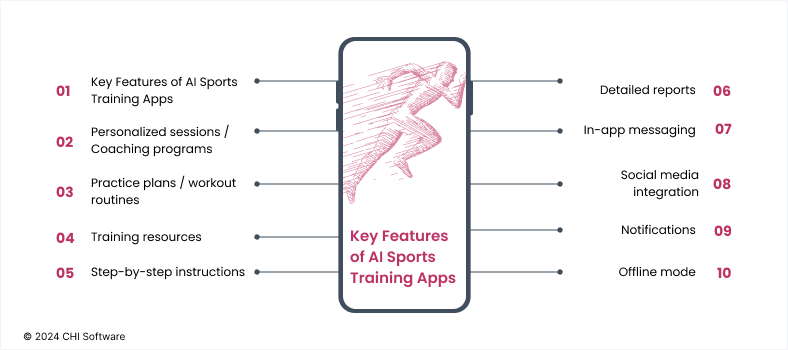
Make sure to consider these features when planning the development process.
- Personalization: With the help of AI, the app should be able to provide personalized recommendations and training plans for each user.
- Progress tracking: It’s important to give users the ability to set short-term and long-term goals and track their progress. You can also add visual progress bars, milestones, and feedback loops.
- Real-time communication and interaction: Ease of communication on the platform is vital to every user, so your application can feature interactive elements like chat and voice messaging.
Saving Lives with Data: Machine Learning in Healthcare
Read more
- Scheduling and integration with the calendar: For systematic training, users need to be able to schedule their workouts directly in the app. Additionally, many popular apps today offersynchronizing with digital planners such as Google Calendar to help athletes organize their tasks.
- Analytics and reporting: With progress analytics, detailed reports, and information on overall development, athletes can assess their level of training and how to improve.
- Security and privacy: Users should be able to control their data, including what information they share and with whom. Of course, all data should be securely encoded.
Which AI Algorithms to Select for Coaching Applications
There are many ways to use AI for training and development. But how do you choose the right algorithms to develop a training application and what should you look for? We are ready to share these insights with you.

There’s a vast variety of options when it comes to AI-based development for sports coaching.
Computer Vision
- Posture assessment algorithms use video to detect pose, body position and movement. In coaching applications, these algorithms are essential for providing feedback on an athlete’s performance;
- Object detection algorithms identify objects in a video stream. They are used to track the use of sports equipment, like detecting a tennis ball in motion;
- Action recognition identifies specific movements or sequences of actions. In sports apps, the main application of this innovation is the recognition of movements: for example, a tennis serve or a basketball shot.
Deep Learning
- Convolutional Neural Networks (CNNs) are deep learning models designed to process and analyze visual data. The use of these particular algorithms is responsible for the best examination of visual inputs.
- Recurrent Neural Networks (RNNs) are used to process sequential data, such as time series of data or sequences of actions. This algorithm allows a training application to analyze progress in a particular exercise or predict the next step.
Machine Learning
- Regression models are used to analyze continuous outcomes from input data. In an application, they can estimate various metrics, such as the number of calories burned and improvement or deterioration in performance.
- Clustering algorithms group similar data together. In training apps, they can be used to classify similar workouts or identify patterns in user behavior.
- Classification algorithms assign a classification to data, such as ranking exercises as ‘beginner’ or ‘advanced’.
Developing Wellness Apps for Seniors: Accessibility and Usability Considerations
Read more
Reinforcement Learning
The following algorithms are responsible for analyzing the user’s preferences and adapting training strategies accordingly.
- Deep Q-learning is a reinforcement learning algorithm that teaches the system to perform actions. This algorithm is essential for creating personalized training programmes in an app. Each of these plans will be tailored to the individual user.
- Policy gradient methods directly optimize the decision-making process. This means the necessary refinement of strategies based on user responses and preferences.
- Collaborative filtering, content-based filtering, and hybrid models are great for recommending personalized content. Collaborative filtering suggests content that similar users may find helpful, while content-based filtering recommends items based on specific content elements. A hybrid approach often produces the best results.
Natural Language Processing (NLP)
NLP algorithms in AI-based training applications are used for improved feedback analysis and engaging communication with users.
- Sentiment analysis is used to interpret the emotional tone used in a user’s text messages. This helps other algorithms in the app to assess the user’s satisfaction level.
- Text summarization algorithms condense long pieces of text into shorter ones. It’s a useful feature that can summarize progress reports or workout results.
AI Coaching Apps Worth Learning From
To create an AI-enhanced coaching application, your business must go through many stages, but the result is worth it. To give you more inspiration and motivation, we would like to introduce you to some good examples of AI app development and use.
Humango
This platform is designed to improve the effectiveness of the athletes’ workout by collecting and analyzing athletes’ data, planning their progress, and visualizing the work done. Hugo is responsible for timely updates and personalization. In addition, users will have a chance to get support from a human trainer if you need it.
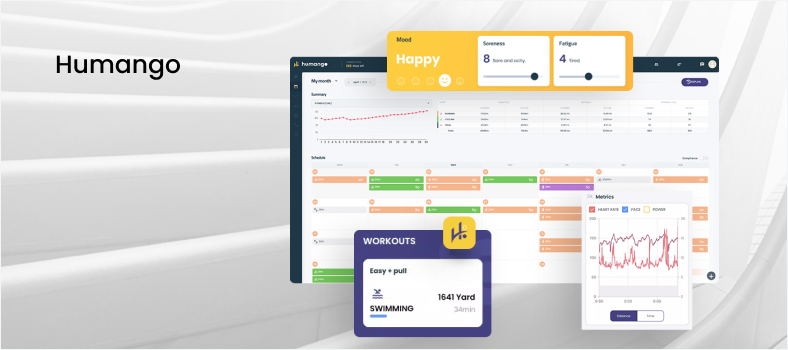
Humango app helps improve athletes’ workouts by analyzing data and offering personalized recommendations.
Another advantage of this app is that it allows athletes to join a community of like-minded people. By analyzing their training data, people can find professionals in the same sport, having similar goals, or at the same stage.
This AI-powered personal training app was developed under the guidance of experienced fitness trainers and physiologists’ supervision, which boosted user trust and retention.
Sportsbox AI
This user-friendly app was developed in 2020 and has been helping professional players, coaches and amateur golfers learn the sport. Users need only record a video of their golf game, and the app will compare their movements with a previously created 3D model of the sport’s movements.
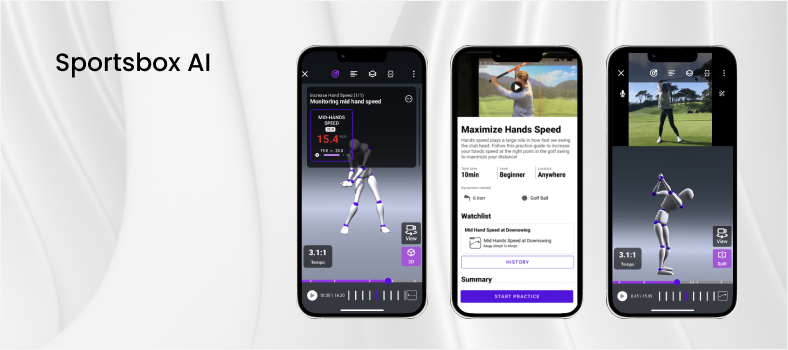
Sportsbox AI helps both professional and amateur golfers improve their skills.
Athletes can also view 3D content before playing and use them as training materials. If the person has been playing golf for a long time and has a coach, the instructor can give the app your exact goal and the app will immediately provide the user with feedback.
Table Tennis AI Coach
CHI Software is undergoing active development of an AI table tennis coach, supporting an Israeli client to update their existing training app using our experience in AI-based sports training app development.
Our improvements allowed the AI-based coaching application to automatically identify the key moments of each game, analyze the player’s technique in detail, track trends that the player tends to follow during the game, and generate reports.
Other advantages of the updated app include independent video processing, removal of downtime to focus the user’s attention on important moments of the game and recognize patterns. These actions simplify the process of analyzing the game and help to develop a more detailed error correction strategy.
We are ready to introduce you to our AI table tennis coach in the next chapter!
СHI Software’s Expertise in AI-Powered App Development
The AI/ML department at CHI Software was founded in 2017. At the beginning, it consisted of just four employees, and now the department employs 80 engineers – 14 of whom have PhDs. In 2021 we became one of the leaders in the cognitive computing and NLP niches, according to Clutch, and in 2022, CHI Software received the AI Excellence award.
Over the years, our specialists have developed 60+ AI business projects in various fields, including vehicle health systems, image/speech/recognition solutions, automated building plan approval systems (ABPAS), geosocial applications, and much more.
AI coaching app development is one of our continuous growth areas, so it’s no surprise why our clients choose us to improve their application. Our case study demonstrates we can build custom AI coaching apps effectively.
Our client from Israel had a goal to boost the efficiency of an already-existing table tennis coaching app with the help of AI implementation. The custom AI coaching app required many development stages to complete. Our team first provided an in-depth analysis of the existing application’s code, then prepared the application for the adaptation of the iOS system, taking into account even the smallest of details.
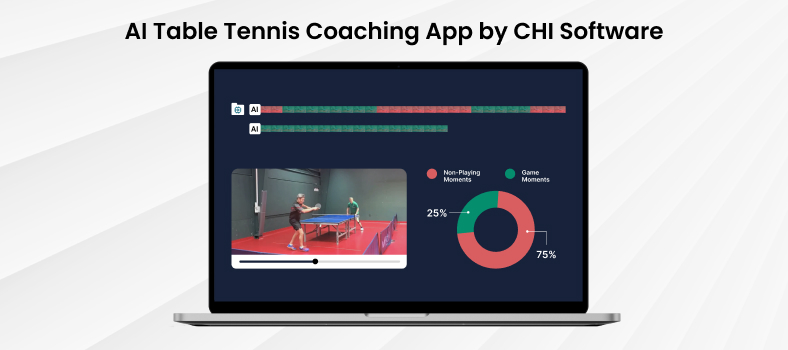
We helped out Israeli client optimize the solution’s workflow.
We started working on this project in October 2023, using such technology stack as Python, Swift, TensorFlow, TensorFlow Lite, CoreML, and Coco API. As a result, we have significantly improved the client’s table tennis application:
- Users have more time to focus on their technique, as the software processes the video without their intervention.
- The app now has the exclusive ability to analyze games from different angles. New ability means that players can look at themselves from a coach’s perspective. The frame also captures the table and both players.
- Recognizing and instantly resolving typical camera placement constraints is now also a feature of the new development.
- Users can identify trends and patterns in their own game, which helps improve each user’s strategy.
- Our algorithm is unique and not available in other AI coaching solutions.
According to our client’s feedback, the app helped to boost time efficiency because the need to manually edit videos practically disappeared. By expanding the variety of angles to watch the game and the ability to follow the game from the coach’s seat, players can see their weaknesses and strengths during the game in the smallest detail. In addition, the software recognizes the tendencies and techniques of each user. Together, these factors significantly help each player improve their performance.
Best Practices for AI Coaching App Development
Developing a scalable AI coaching app can seem like a daunting process, but below we’ll describe the factors you need to consider to make project work.
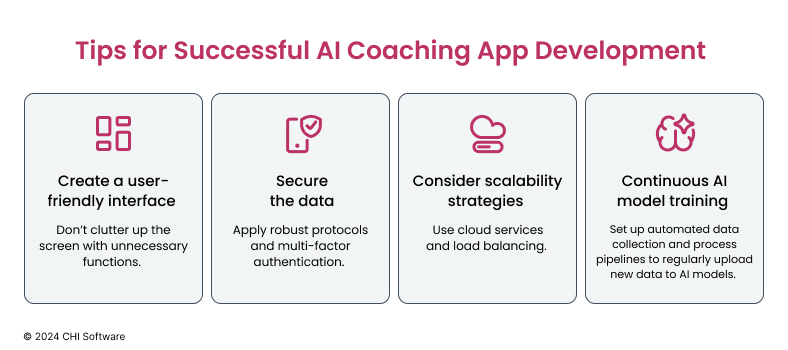
Keep it in mind if you want to build high-quality AI coaching software.
Crafting Intuitive, User-Friendly Interfaces
Developing an intuitive and user-friendly interface will allow users to navigate and interact with the application effortlessly. This approach will prove to users that AI for learning and development is easy to use. So, when developing an app, try to keep the following things in mind:
- There is no need to clutter up the screen with unnecessary functions; it is better to simply provide uncomplicated access to the main ones;
- Ensure the app works smoothly on different devices;
- It will be a great advantage to make the interface interactive by adding chatbots or visualizations of the athlete’s progress.
Over time, you must implement testing to collect user feedback and improve the app.
Cybersecurity in Healthcare: Protecting Patient Data
Read more
Securing Data
Creating an AI-enhanced coaching application involves a lot of data, so data security at the development and use stages is paramount:
- Multi-factor authentication (MFA) is a method of accessing information by performing more than one action. It ensures that only authorized users can access the app and its information, increasing protection against privacy breaches;
- Reviewing and updating your security practices keeps your solution safe from various threats and helps identify system weaknesses on time;
- Ensuring compliance with relevant data protection regulations, such as GDPR or HIPAA, is crucial to maintaining user trust and avoiding legal conflicts.
- Develop a comprehensive incident response plan as early as the coding stage. The plan should include procedures for responding and detecting, containing, and mitigating the damage from a breach.
Applying Scalability Strategies
We recommend implementing secure scalability tools to ensure that your application works efficiently when demand for it increases and new users join. Follow these tips for the best result:
- Use cloud services to scale resources based on demand dynamically. By using cloud platforms such as AWS, Google Cloud or Azure, it will be possible to automatically increase or decrease resources based on demand;
- Load balancing will be another helpful factor. To ensure that each server is running optimally, you need to use load balancers;
- Implement a microservices architecture. Break your application into smaller, independent microservices that perform specific functions. This will allow each service to scale independently of the overall load;
- Optimize the deployment of AI/ML models. Reducing the size and complexity of models without sacrificing accuracy can help them scale more efficiently;
- Use a CDN to deliver content such as images, videos, and scripts from servers closest to the user. This will improve the user experience while reducing the load on the server. Some CDNs also offer dynamic content acceleration.
Such processes ensure stable performance by evenly distributing user traffic between servers.
Continuously Training AI Models
Regular updates based on the data obtained will maintain the app’s performance to keep it practical and relevant. To perform new and more complex tasks, AI needs to constantly learn and adapt to interact with users. Therefore, it is worth setting up automated data collection and processing pipelines to regularly upload new data to AI models. You can also incorporate user feedback into the training process so that the programme improves recommendations and responses.
You can also follow the detailed journey of developing AI in sports solutions, with a list of our tips and tricks.
Conclusion
AI in training and development is a revolutionary breakthrough. In this article alone, we’ve listed many benefits to demonstrate the ever-growing demand for AI across a wide range of industries.
This article aims to simplify the understanding of how to develop an AI coaching app, introduce various technical components, and provide examples of successful projects.
By using a variety of algorithms and real-time data analysis, AI training tools allow athletes to progress faster and focus on the process rather than planning. 24/7 accessibility and real-time feedback are also changing how sports teams approach training. We are confident that integrating artificial intelligence into the sports industry will help improve the performance of athletes at all levels.
If you have any questions or suggestions, we are happy to accept your requests for consultation.
FAQs
-
How long does it take to develop an AI coaching app?

The answer to this question depends on the scope of work, the complexity of your future project, the availability of data, and many other components, but the general estimated time required to build a new AI training application ranges from six to 12 months.
-
What is the cost range for developing an AI-powered coaching app?

AI coaching app development cost depends on several factors, from choosing the right type of AI to deployment and maintenance, so the price varies – but the price for the development of a new AI-driven application starts from USD 33,000 and can reach USD 300,000.
-
Can AI coaching apps be customized for specific industries?

Yes, AI coaching apps can definitely be adapted for various industries, such as:
- Healthcare and sports;
- Education and eLearning;
- Corporate training and professional development;
- Sales and customer service;
- Finance and investment;
- Real estate and many others.
For the most accurate definition of the goals of your future AI application, we recommend contacting CHI Software’s analysts, and our professionals will be able to provide you with a detailed analysis of your needs and ways to implement them in an AI application.
-
What kind of post-launch support do you offer for AI coaching apps?

CHI Software offers comprehensive post-launch support for AI applications. Through our ongoing technical support, we guarantee:
- Error correction, problem resolution, and performance optimization;
- Continuous application updates, including internal algorithm updates;
- Adding new features or improve existing ones as use needs change;
- Regular security audits and elimination of any potential vulnerabilities;
- Scaling your application infrastructure to manage a growing user base.
-
How do you ensure data privacy and compliance in AI coaching apps?

The security of our customers' data is a priority for us. To ensure data confidentiality and compliance with regulatory requirements, we use the following tools:
- Encryption and secure data storage,
- Compliance with data protection regulations (GDPR, HIPAA, and CCPA),
- Multi-factor authentication (MFA),
- Regular security audits and testing,
- Data anonymization and minimization,
- Continuous monitoring and incident response.
About the author
Alex is a Data Scientist & ML Engineer with an NLP specialization. He is passionate about AI-related technologies, fond of science, and participated in many international scientific conferences.
Rate this article
27 ratings, average: 4.56 out of 5









